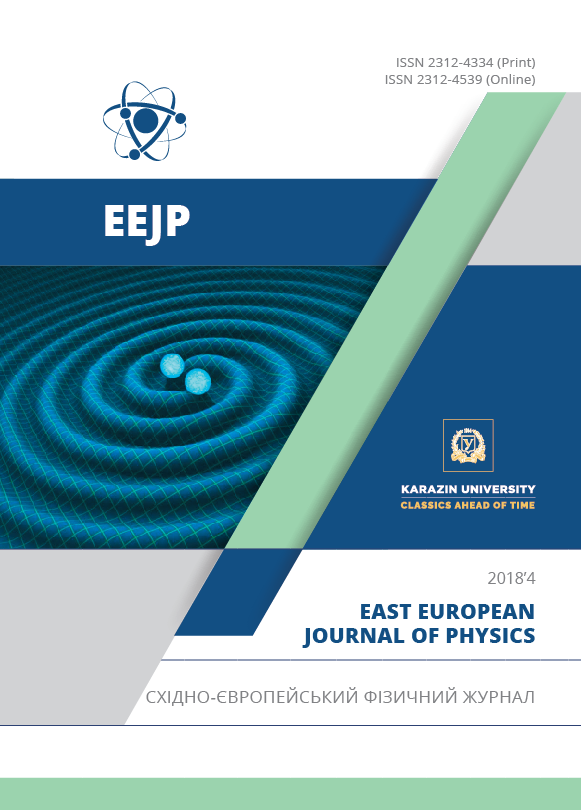Growth of Europium-Doped Magnesium Selenide Films by Electric Field-Assisted Spray Pyrolysis: Optical and Structural Analysis
Abstract
Europium-doped MgSe films were deposited via electric field-assisted spray pyrolysis. The dopant concentration of the bulk solution of europium trioxide was 5wt. %. However, for doping the films at different substrate temperatures, volume percentage (vol. %) was employed at each instance of variation. Variation of spray temperature was around 573K and 673K (±0.3). Deposition occurred at optimized conditions. Spectra of absorption indicate poor absorption characteristics demonstrated by Europium-doped MgSe films in the ultra-violet region and very low absorption characteristics in the visible section. Absorption peaks were evident around 230nm, 240nm, 350nm and 365nm which confirmed defect states are inherent inside the crystal structure of the films. The films displayed high transparency and low reflection in the visible section at varying substrate temperatures. The high transparency revealed by the MgSe:Eu films in the visible section of the electromagnetic spectrum makes the material applicable as a coating layer in the manufacturing of transparent products. Band gap energies within the range of 2.49eV to 2.95eV corresponding to varying substrate temperatures (573K, 598K, 623K, 648K and 673K) and film thicknesses (2900nm, 2750nm, 2500nm, 2100nm and 200nm) were determined for the MgSe:Eu films. However, a clear observation shows that the band gaps of MgSe:Eu films are mainly dependent on thickness such that the obtained band gaps decreased with increasing thickness (band gap increases with thickness reduction). Structural analysis (XRD) studied at 10% and 40% Eu concentrations reveals a hexagonal (or wurzite) structure for the films with a distortion in crystallinity at higher dopant concentration (40 vol. %) and a resultant blue shift in the lattice constant from the bulk value. Multiple planes of reflection from XRD pattern of the deposited MgSe:Eu films indicate clearly that the films are polycrystalline. Surface morphology (SEM) confirms the highly strained nature and the presence of defect states within the crystal lattice of the Europium-doped MgSe films. Composition of MgSe:Eu films obtained by energy dispersive analysis x-ray (EDAX) confirms the growth of MgSe:Eu films.
Downloads
References
Y.S. Sakhare, N.R. Thakare and A.U. Ubale, St. Petersburg Polytech. Uni. J. Phys. Math. 2, 7-26 (2016).
S.J. Gnanamuthu, S.J. Jeyakumar, A.R. Balu, K. Usharani and V.S. Nagarethinam, Int. J. Thin Fil. Sci. Tech. 2, 121 123 (2015).
Y.S. Sakhare, N.R. Thakare and A.U. Ubale, Arch. Phys. Res. 6, 12-20 (2015).
A.U. Ubale, Y.S. Sakhare, Vacuum. 99, 124 (2014).
A.U. Ubale, Y.S. Sakhare, Mater. Sci. Semicond. Process. 16, 1769 (2013).
A.U. Ubale, Y.S. Sakhare, S.G.Ibrahim and M.R. Belkhedkar, Solid State Sci. 23, 96-108 (2013).
A.U. Ubale, Y.S. Sakhare, Ind. J. Phys. 87, 1183-1188 (2013).
H.M. Wang, J.H. Chang, T. Hanada, K. Arai and T. Yao, J. Cryst. Growth. 208, 253-258 (2000).
P.X. Feng, J.D. Riley, R.C.G. Leckey and L. Ley, J. Phys.: Appl. Phys. D. 34, 1293-1300 (2001).
F. Jiang, Q. Liao, G. Fan, C. Xiong, X. Peng, C. Pan and N. Liu, J. Cryst. Growth. 183, 289–293 (1998).
P. Prete, N. Lovergine, L. Tapfer, C.Z. Fregonara and A.M. Mancini, J. Cryst. Growth. 214-215, 119-124 (2000).
M.D. Jeroh, A.J. Ekpunobi, D.N. Okoli, J. Nano- Electron. Phys. 10, 03006-1 (2018).
D.H. Hwang, J.H. Ahn, K.N. Hui, K.S. Hui and Y.G. Son, Nanoscale Res. Letts. 7, 26 (2012).
M Suganya, A.R. Balu and K. Usharani, Mater Sci Poland. 3, 448–456 (2014).
Standard X-ray Diffraction Powder Patterns. National Bureau of Standards Monograph, 25 - Section 5, (US Department of Commerce, Washington, 1967).
N.J.S. Kissinger, M. Jayachandran, K. Perumal and C.S. Raja, Bull. Mater. Sci. 3, 547-551 (2007).
R.S. Meshram, R.M. Thombre, Int. J. Adv. Sci. Eng. Technol. 1, 161-170 (2015.).
S. Muthumari, G. Devi, P. Revathi and R. Vijayalakshmi, J. Appl. Sci. 12, 1722-1725 (2012). doi: 10.3923/jas.2012.1722.1725
J. Pla, M. Tamasi, R. Rizzolt, M. Losurdo, E. Centurioni, C. Summonte and F. Rubinelli, Thin Solid Films. 425, 185 192 (2003).
Y.Z. Dawood, M.H. Hassoni and M.S. Mohamad, Int. J. Pure. Appl. Phys. 2, 1-7 (2014).
N.J.S. Kissinger, J. Suthagar, B.S. Kumar, T. Balasubramaniram and K. Perumal, Acta. Phys. Pol. A. 118, 623-628 (2010).
V.D. Mote, J.S. Dargad and B.N. Dole, Nanosci. Nanoeng. 1, 116-122 (2013). doi: 10.13189/nn.2013.010204
Z.R. Khan, M. Zulfequar and M.S. Khan, Mater. Sci. Eng. B. 174, P.145-149 (2010).
S.A. Aly, A.A. Akl and H. Howari, Acta. Phys. Pol. A. 128, 414-418 (2015). doi: 10.12693/APhysPolA.128.414
Authors who publish with this journal agree to the following terms:
- Authors retain copyright and grant the journal right of first publication with the work simultaneously licensed under a Creative Commons Attribution License that allows others to share the work with an acknowledgment of the work's authorship and initial publication in this journal.
- Authors are able to enter into separate, additional contractual arrangements for the non-exclusive distribution of the journal's published version of the work (e.g., post it to an institutional repository or publish it in a book), with an acknowledgment of its initial publication in this journal.
- Authors are permitted and encouraged to post their work online (e.g., in institutional repositories or on their website) prior to and during the submission process, as it can lead to productive exchanges, as well as earlier and greater citation of published work (See The Effect of Open Access).








